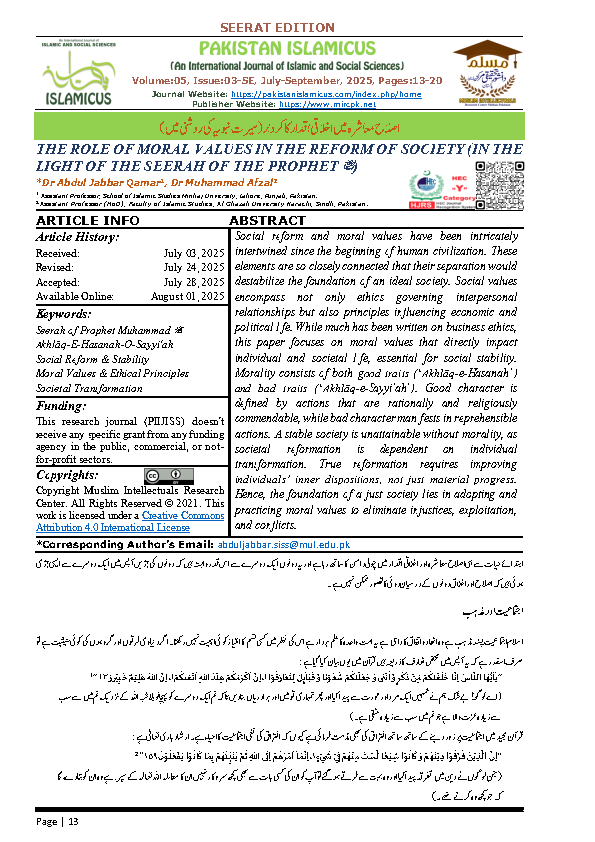اصلاح معاشرہ میں اخلاقی اقدارکا کردار(سیرت نبویہ کی روشنی میں)
THE ROLE OF MORAL VALUES IN THE REFORM OF SOCIETY (IN THE LIGHT OF THE SEERAH OF THE PROPHET ﷺ)
Keywords:
Seerah of Prophet Muhammad ﷺ; Akhlāq-E-Hasanah-O-Sayyi'ah; Social Reform & Stability; Moral Values & Ethical Principles; Societal Transformation.Abstract
Social reform and moral values have been intricately intertwined since the beginning of human civilization. These elements are so closely connected that their separation would destabilize the foundation of an ideal society. Social values encompass not only ethics governing interpersonal relationships but also principles influencing economic and political life. While much has been written on business ethics, this paper focuses on moral values that directly impact individual and societal life, essential for social stability. Morality consists of both good traits ("Akhlāq-e-Hasanah") and bad traits ("Akhlāq-e-Sayyi'ah"). Good character is defined by actions that are rationally and religiously commendable, while bad character manifests in reprehensible actions. A stable society is unattainable without morality, as societal reformation is dependent on individual transformation. True reformation requires improving individuals’ inner dispositions, not just material progress. Hence, the foundation of a just society lies in adopting and practicing moral values to eliminate injustices, exploitation, and conflicts.
References
Al-Ḥujurāt 49:13. (2025). In Al-Qur’ān al-Karīm.
Al-An‘ām 6:159. (2025). In Al-Qur’ān al-Karīm.
Abū Dāwūd, S. ibn A. ibn I. ibn B. ibn Shaddād ibn ʿAmr al-Azdī al-Sijistānī. (1414 H). Al-Sunan (Vol. 4, p. 241, ḥadīth 4758). Beirut, Lebanon: Dār al-Fikr.
Dar, B. A. (n.d.). Qur’ān Majīd kā naz̤ariyah-i akhlāq (pp. 29–30).
Al-Jurjānī, ʿA. ibn M. ibn ʿA. al-Jurjānī. (1405 H). Al-Taʿrīfāt (p. 135). Beirut, Lebanon: Dār al-Kitāb al-ʿArabī.
Al-Bayhaqī, A. ibn al-Ḥusain ibn ʿA. ibn M. al-Khurāsānī. (1414 H). Al-Sunan al-kubrā (Vol. 10, p. 191, ḥadīth 21301). Makkah al-Mukarramah, Saudi Arabia: Maktabah Dār al-Bāz.
Al-Nasāʾī, A. ibn Shuʿayb ibn ʿA. (1416 H). Al-Sunan (Vol. 6, p. 67, ḥadīth 1583). Beirut, Lebanon: Dār al-Kutub al-ʿIlmiyyah
Al-Qalam 68:4. (2025). In Al-Qur’ān al-Karīm.
Abū Dāwūd. (n.d.). Al-Sunan (Vol. 4, p. 220, ḥadīth 4682).
Aḥmad ibn Ḥanbal. (n.d.). Al-Musnad (Vol. 50, p. 110, ḥadīth 23454).
Al-Bukhārī, M. ibn Ismāʿīl. (2001). Al-Adab al-mufrad (p. 111, Bāb: Man lā yuʾdhī jārahū). Damascus: Dār al-Qalam.
ʿAzīz ur Raḥmān. (2014). Uswah ḥasanah ke chand ʿamalī pehlu (p. 110). Karachi: Zawwar Academy Publications.
Al-Ḥujurāt 49:10. (2025). In Al-Qur’ān al-Karīm..
Aḥmad ibn Ḥanbal. (n.d.). Al-Musnad (Vol. 19, p. 430, ḥadīth 9387).
Ibn Saʿd, A. M. ibn Saʿd. (2014). Al-Ṭabaqāt al-kubrā (2nd ed., Vol. 1, p. 238). Beirut, Lebanon: Dār Ṣādir
Muslim ibn al-Ḥajjāj. (n.d.). Al-Ṣaḥīḥ (Vol. 4, p. 2000, ḥadīth 2586, Kitāb al-Birr, Bāb tarāḥum al-muʾminīn).
Al-Tirmidhī. (n.d.). Al-Sunan (Vol. 9, p. 215, ḥadīth 2551).
Alawī, Kh. (n.d.). Islām kā muʿāshratī niẓām (p. 416).
Dar, B. A. (n.d.). Qur’ān Majīd kā naz̤ariyah-i akhlāq (p. 46).
Al-Ḥujurāt 49:13. (2025). In Al-Qur’ān al-Karīm.
Muslim ibn al-Ḥajjāj al-Qushayrī al-Naysābūrī. (n.d.). Al-Jāmiʿ al-ṣaḥīḥ (Vol. 4, p. 1990, ḥadīth 2569). Beirut, Lebanon: Dār Iḥyāʾ al-Turāth al-ʿArabī.
Qamar R. (1966). Taʿmīrī fikr (p. 180). Lahore: Jadīd Nashreen.
Al-Ḥujurāt 49:12. (2025). In Al-Qur’ān al-Karīm.
Abū Dāwūd. (n.d.). Al-Sunan (Vol. 4, p. 354, ḥadīth 4880, Kitāb al-Adab, Bāb fī al-ghībah).
Ḥakīm, M. S. (1982). Akhlaqiyāt-i nabawī (pp. 12–13). Karachi: Hamdard Foundation.
Banī Isrāʾīl 17:37. (2025). In Al-Qur’ān al-Karīm.
Muslim ibn al-Ḥajjāj. (n.d.). Al-Jāmiʿ al-ṣaḥīḥ (Vol. 1, p. 247, ḥadīth 131).
Al-Muʾmin 40:28. (2025). In Al-Qur’ān al-Karīm.
Muslim ibn al-Ḥajjāj. (n.d.). Al-Jāmiʿ al-ṣaḥīḥ (ḥadīth 210).
Banī Isrāʾīl 17:34. (2025). In Al-Qur’ān al-Karīm.
Al-Nisāʾ 4:58. (2025). In Al-Qur’ān al-Karīm.
Abū Dāwūd. (n.d.). Al-Sunan (Vol. 3, p. 276, ḥadīth 3534).
Aḥmad ibn Ḥanbal. (n.d.). Al-Musnad (Vol. 3, p. 594).
Aḥmad ibn Ḥanbal. (n.d.). Al-Musnad (Vol. 2, p. 370, ḥadīth 6614).
Ḥakīm, M. S. (1982). Akhlaqiyāt-i nabawī (p. 10). Karachi: Hamdard Foundation.
Maṭīn Hāshmī. (1997). Roshni (Vol. 1, p. 515). Lahore: Dār al-Tazkir
Dar, B. A. (1989). Qur’ān Majīd kā naz̤ariyah-i akhlāq (p. 137). Lahore: Islamic Book Service.

Downloads
Published
Issue
Section
License
Copyright (c) 2025 PAKISTAN ISLAMICUS (An International Journal of Islamic & Social Sciences)

This work is licensed under a Creative Commons Attribution 4.0 International License.
This work is licensed under a Creative Commons Attribution 4.0 International License.

































